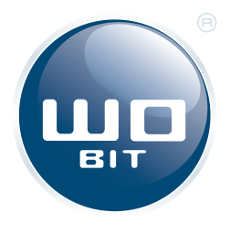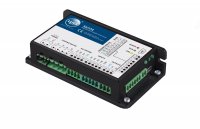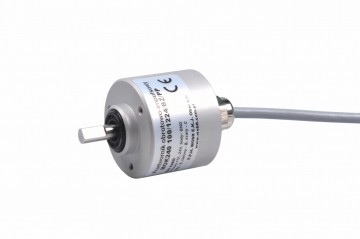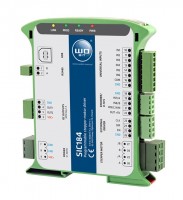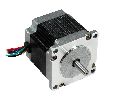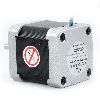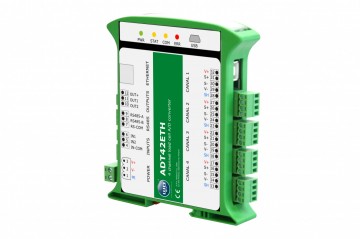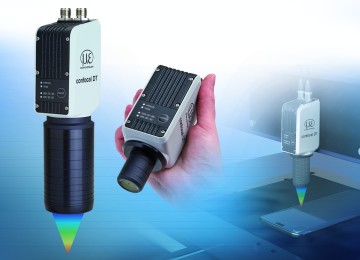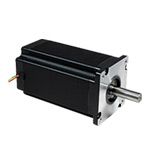
ServonapĂŠs are one of the basic elements in executive applications in automation. Thanks to the work in the closed loop of the feedback, they are used wherever there is a need for high dynamics of movement, positioning, work at very low speeds, high control accuracy or precise movement from one position to another. Currently, the most common use are synchronous motors of alternating current AC or constant current BLDC as servo drives. Unfortunately, these are often solutions that are not expensive or do not always coincide with the requirements of the application. An alternative to such solutions is a stepper motor controlled from a PLC and & quot; power & power & amp; or a dedicated motion controller.
Construction and principle of servo drive
A servo drive is nothing more than a constant or alternating current motor, which in combination with a dedicated controller and an element that reads the actual rotational speed or position of the motor (eg an encoder) allows you to accurately execute a specified amount of rotation and task speed and acceleration. This is possible thanks to the work in the so-called closed control loop (Fig.1).
Â
The servo disk is composed of the following parts & in:
- An actuator called a servo motor, e.g. an AC synchronous motor,
- Regulator / driver called servo controller & ndash; implementing a specific engine control algorithm (eg PID, control of speed, current, torque, position) based on the & oacute; parameter in the given and read out of the feedback element,
- A feedback element - used to read the current position or the actuator speed (motor) - usually an encoder, resolver or tachometer.
 |
| Rys. 1 Schemat blokowy zamkniętego układu regulacji w serwonapędzie. |
The regulator's task is to control the engine on the basis of data from the measuring element (eg an encoder) to obtain the required effect - eg displacement of the engine shaft by a specific angle, obtaining the desired number of revolutions / speed of the engine shaft. Depending on the control algorithm method used, the motor can maintain the desired position, rotational speed or torque independent of the operating fault (eg load on the motor shaft, voltage drop).
Stepper motor as an alternative to servo drive
Stepper motors have gained a lot of popularity in the drive systems, thanks to their uncomplicated design, high output torque without transmission and simple control. Despite the inferior & oacute; parameter in traffic in many systems, they can successfully compete with DC servo drives or much better in terms of the & oacute; parameter in modern AC / BLDC servo drives, and in some cases even irreplaceable. Hybrid stepper motors are currently the most popular (Figure 2)
 |
| Rys. 2 Silnik krokowy hybrydowy |
The biggest advantages of the stepper motor are the high torque and the way it is controlled, which allows the task of speeding or motor positioning with a precision to fractions in steps without the use of additional elements in the feedback coupler, such as an encoder.
In the stepper motor, the pulses fed to the winding cause that the rotor does not rotate in a continuous motion, but always makes a leap with a precisely defined angle. For typical motor & oacute; w it is 1.8 degrees. Due to this, the rotation angle of the rotor is dependent on the number of pulses supplied, and pr Ĺ?dkoĂ?Ĺ?Ä?Ĺ? is r & oacute the frequency of feeding these impulses & w.
The stepper motor for correct operation requires the use of a power controller for the pulse & current in the currents on its windings. Modern stepper motor controllers allow you to work in & quot; microstep & quot; dividing the basic step (step) of the engine into smaller values. For example, the stepper motor controller with the division of step 1/256 allows you to determine the position of the engine shaft with accuracy up to 360/200/256 - & gt; 0.007 degree! no additional element in the controlling position, such as an encoder.
 | Rys. 3 Charakterystyka porównawcza moment-prędkość. |
Stepper motors are characterized by lower rotational speed than commutator and brushless motors, however, a much larger torque, and also a significant dynamic of motion. For a stepper motor, full torque at zero speed is a normal state, not a forbidden short circuit, as for other types of & oacute; engine & oacute.
Fig. 3 shows the dependence of torque on the rotational speed of the stepper motor in relation to the other drive & oacute. It is clearly visible that the useful speed for the stepper motor closes to a value of around 500 [rpm], where for these speeds the torque is sometimes several times higher than in the case of another type of motor & w.
Thanks to high torque and lower speed, stepper motors often replace drives assembled from a servo drive and a converter operating at low speed.
Precise motion control of the stepper motor
The stepper motor requires the use of a stepper motor power controller (power wheel) and a device that transmits traffic signals such as Step / Direction. The device that assigns these pulses can be a simple rectangular signal generator, a PLC with high-frequency outputs, or a dedicated motion trajectory generator.
 | Rys. 4 Programowalny sterownik silnika krokowego SIC184. |
The WObit company in its offer has a SIC184 driver, which combines a power controller and a programmable trajectory generator with an indexer that allows any motor motion to be executed, and can also perform the role of a small PLC driver by executing a program from its memory. br />
 |
| Rys. 5 Sterownik SIC184 jako kompleksowe rozwiązanie w sterowaniu silnikiem krokowym. |
The SIC184 controller allows you to completely eliminate the PLC and direct control of the stepper motor up to 4A. If the built-in power controller is too weak for the motor used, you can connect an external higher power controller or, for example, two r & oacute controllers, and two parallel motors.
The trajectory controller built into the SIC184 allows precise positioning, speed and acceleration of motor motion. The user can freely customize the parameters of the so-called & quot; ramps & quot; to obtain optimal engine operating conditions for a given application (Figure 6).
 |
| Rys. 6 Przykład trajektorii ruchu generowanej przez sterownik SIC184 |
The power controller built into SIC184 allows you to control the stepper motor with the division of steps up to 1/64. This allows you to set the position of the engine shaft with a precision of 0.028 degrees and work in a wide range of speeds from 0 (minimum rotational speed 0.048 [revs / min]) to 5400 [rev / min].
The controller allows programming of up to 300 motion commands, which allows to perform even complex traffic tasks, and additional digital inputs and outputs allow control of external devices. In addition, the controller can be used, it works with an incremental encoder, which allows even greater control of the position of the stepper motor.
Multi-drive control
In automation, it is often necessary to control several drives at the same time, where the most frequent movements of individual drives must be synchronized with one another.
The SIC184 controller is equipped with the popular RS485 MODBUS-RTU interface, which allows you to communicate with other devices on this bus, being in the next slave device (SLAVE). The controllers can be addressed in the range 1-16, which allows simultaneous control of up to 16 motors in step with devices such as PLC controllers or HMI operator panels. The open communication protocol MODBUS-RTU also allows you to control from your own applications created on PCs and control devices.
 |
| Rys. 7 Praca sterowników SIC184 w sieci RS485 MODBUS-RTU. |
Programming of the SIC184 driver
Programming of the controller takes place from a simple ML-PROG application, in which individual instructions are saved in the form of commands such as & quot; Eat on position (X) & quot ;, Set the speed ((X) & quot; , & quot; Jump to line X when input 1 active & quot ;, & quot; Set output 2 & quot; etc. (Fig. 8).
It is possible to create a program for the 16th driver in the same time. The programmed controllers can function independently or communicate with each other on the basis of the MASTER-A & ndash; MASTER-B.
 |
| Rys. 8 Wygląd aplikacji ML-PROG do tworzenia programów ruchu sterownika SIC184. |
 |
| Rys. 9 Jednoczesne programowanie i komunikacja ze sobą wielu sterowników SIC184 |
The SIC184 controller is additionally equipped with a USB connector, which allows you to connect the controller directly to your PC. The additional software SIC184-KONFIGURATOR gives you the possibility to configure the driver and its quick diagnostics (signal control & oacute; in input / output, controller operation & quot; online & quot; etc.), as well as direct command of traffic commands. The software also allows you to program the controller with motion commands created in the ML-PROG environment.
Â
Adam SarzyĂąski
a.sarzynski@wobit.com.pl
Coordinator of the Department of Research and Development
P.P.H. WObit E.K.J. Ober s.c.
